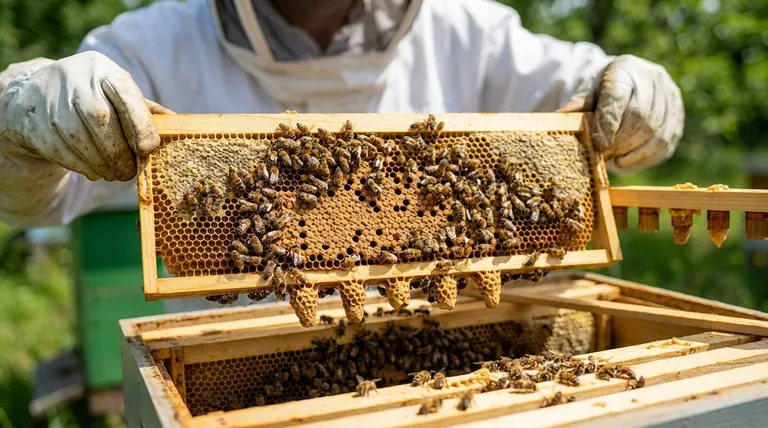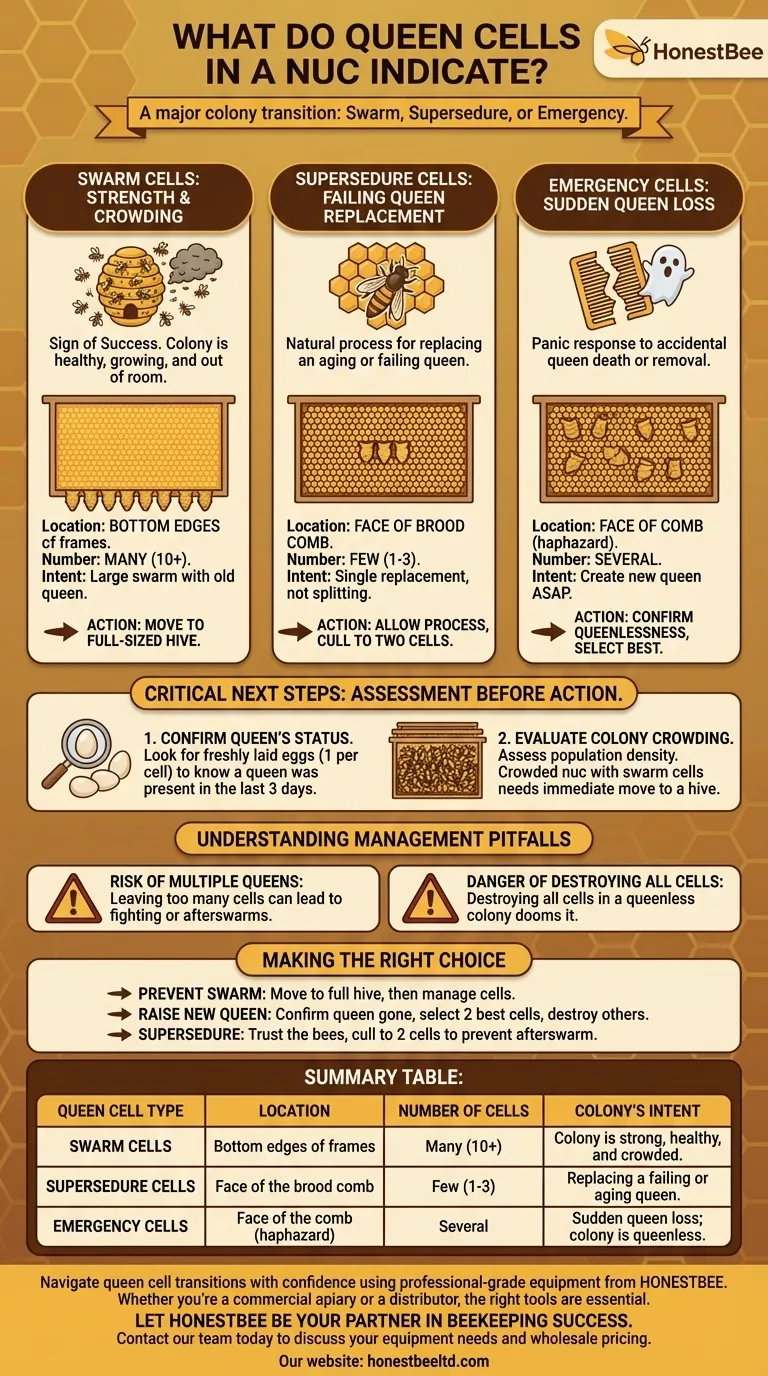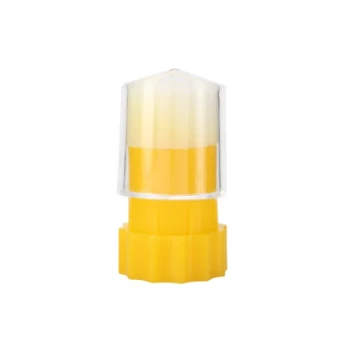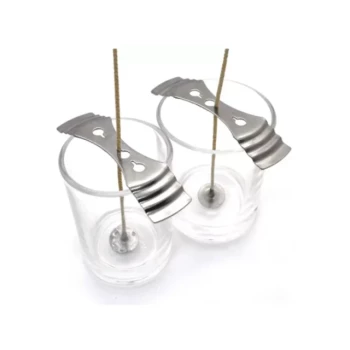In short, queen cells in a nuc indicate the colony is undergoing a major transition. The bees are either preparing to swarm because they've outgrown their space, replacing a failing queen in a process called supersedure, or making an emergency replacement because their queen was suddenly lost. Understanding which of these three situations is occurring is critical to managing the colony correctly.
The presence of queen cells transforms a nucleus hive from a simple starter colony into one at a critical decision point. Your first step is not to panic and destroy the cells, but to diagnose the colony's underlying intention by observing the cells' location, number, and the status of the current queen.

Diagnosing the Colony's Intent: Swarm, Supersedure, or Emergency?
The type and placement of queen cells are your most reliable clues. Each signals a different need within the colony and requires a different management response.
Swarm Cells: A Sign of Strength and Crowding
Swarm cells are a sign of success. The colony is healthy, growing, and has simply run out of room in the small nuc box.
These cells are typically found along the bottom edges of the frames. You may see many of them, often a dozen or more, as the bees prepare to issue a large swarm with the old queen.
Supersedure Cells: Replacing a Failing Queen
Supersedure is the bees' natural process for replacing a queen who is aging, poorly mated, or has stopped laying effectively. It is a controlled, internal process.
These cells are usually found on the face of the brood comb, not the bottom. You will typically only see a few—often just one to three—as the colony is only trying to create a single replacement, not split its population.
Emergency Cells: A Response to Sudden Queen Loss
If the queen is accidentally killed or removed, the workers will panic and initiate emergency procedures to create a new one.
Like supersedure cells, these are built on the face of the comb. However, they are made by modifying an existing worker-larva cell, so they may appear more haphazard. The colony will often create several in the hopes that at least one is successful.
Critical Next Steps: Assessment Before Action
Before you remove a single cell, you must gather more information. Acting without a full diagnosis can doom the colony.
Confirm the Queen's Status
Your first job is to determine if a queen is present and laying. Carefully inspect the frames for the queen herself.
More importantly, look for freshly laid eggs. If you see eggs (tiny, rice-like grains, one per cell), you know a queen was present in the last three days. This makes a swarm or supersedure event more likely. If you see no eggs or young larvae, the colony is likely queenless.
Evaluate Colony Crowding
Assess the population density. If the bees are covering every frame and there is little room for the queen to lay or for foragers to store resources, the pressure to swarm is immense.
A crowded nuc with plenty of swarm cells is a clear indicator that they need to be moved into a full-sized hive immediately.
Understanding the Management Pitfalls
Your intervention, or lack thereof, has significant consequences. Rushing to a decision is the most common mistake.
The Risk of Multiple Queens
Leaving too many queen cells can create its own problems. If multiple virgin queens emerge at once, they may fight to the death.
Alternatively, the first virgin queen to emerge can leave with a secondary swarm (an "afterswarm"), taking a portion of the nuc's already small population with her. Leaving four or more queen cells significantly increases this risk.
The Danger of Destroying All Cells
A beekeeper's first instinct might be to destroy all queen cells to stop a swarm. This is a critical error if the colony is actually queenless or in the process of supersedure.
If you destroy all their queen cells without confirming the presence of a healthy, laying queen, you have just made it impossible for the colony to save itself.
Culling to the Best Candidates
The standard practice is to select the two or three largest, best-formed queen cells and carefully remove the rest. This provides the colony with a primary queen and a backup, while drastically reducing the chance of afterswarms.
Making the Right Choice for Your Nuc
Your actions should align with the evidence you've gathered and your goals for the colony.
- If your primary focus is to prevent a swarm and grow the colony: Immediately move the frames into a full-sized hive to relieve congestion. You can then decide whether to remove all swarm cells or allow them to requeen.
- If your primary focus is to raise a new queen from these genetics: Confirm the old queen is gone (or remove her), select the two best-looking queen cells, and destroy the others.
- If you believe the bees are superseding a failing queen: You can trust their judgment. Allow the process to continue, but cull down to two cells to prevent an accidental afterswarm.
By learning to read the language of queen cells, you can guide your colony through this critical transition and ensure its future success.
Summary Table:
| Queen Cell Type | Location | Number of Cells | Colony's Intent |
|---|---|---|---|
| Swarm Cells | Bottom edges of frames | Many (10+) | Colony is strong, healthy, and crowded. |
| Supersedure Cells | Face of the brood comb | Few (1-3) | Replacing a failing or aging queen. |
| Emergency Cells | Face of the comb (haphazard) | Several | Sudden queen loss; colony is queenless. |
Navigate queen cell transitions with confidence using professional-grade equipment from HONESTBEE.
Whether you're a commercial apiary managing hundreds of nucs or a distributor supplying beekeepers, the right tools are essential for successful colony management. Our wholesale-focused operations provide durable, reliable beekeeping supplies designed for efficiency and colony health.
Let HONESTBEE be your partner in beekeeping success. Contact our team today to discuss your equipment needs and wholesale pricing.
Visual Guide

Related Products
- Brown Nicot Queen Cell Cups for Breeding Queen Bees Beekeeping
- JZBZ Push-In Queen Cell Cups for Beekeeping
- JZBZ Type Wide Base Plastic Queen Cell Cups for Base Mounting and Queen Rearing
- Clear Black Plain Polystyrene Queen Bee Grafting Cell Cups No Lug for Bee Queen Cup
- JZBZ Langstroth Queen Rearing Frame for Beekeeping
People Also Ask
- How many cells are given to a nucleus? Understand the One-to-One Rule in Cell Biology
- What are the ideal conditions for raising good queen cells? Achieve Robust Queens with Strong Cell-Builder Colonies
- How are the queen cells raised after removing the plugs? Master the Art of Queen Rearing
- What are the signs that a queen cell is about to emerge? Master the Critical Timing for Hive Success
- What is the advantage of the Nicot Cupkit system? Secure Your Queen Rearing Success with Batch Protection














